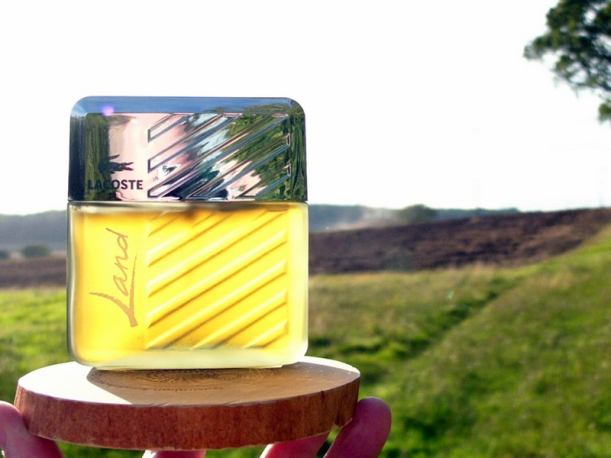
Perfumes of the Land and Sea
Part One, Two and Three
By Dr. John King
Dr. John King from the UK considers fragrances that
remind him of home and abroad.
Fragrances of the great outdoors have always appealed to me more than stylized perfumes.
The fleeting scents of wind and water, forests and lakes, sea beaches and driftwood fires –
these have thrilled me more than anything usually found in a bottle. But there are exceptions.
The perfume industry, led by firms like Givaudan, have developed the concept of ‘olfactory
scenery’, recreating for example the ambience of the Mediterranean coastline, or even venturing
out over the rainforest in airships to capture the exotic aromas there.
"This technology (ScentTrek) has enabled true reconstructions
of aspects of our beautiful planet, fragrant memories of the
wilderness which contribute to the success of many of today's
perfumes."
Perfumery has always been about travel, adventure, exotic aromatics from mysterious lands. So the choice I have in writing about perfumes
evocative of places, is vast. All over the globe fragrances are sold to tourists as unique souvenirs of wherever they are visiting, and to do justice
to all these products is impossible. So I have just singled out a random few which have made an impression on me, with apologies to the many
excellent ones that have been omitted.
England: my home territory
Close to where I live in central
England are the Malvern Hills,
the name deriving from the
ancient British words Moel and
Vern, meaning bare mountain.
They have inspired many
Englishmen, not least our
greatest composer Edward Elgar
(who wrote the patriotic
‘Land of Hope and Glory’).
My mission has always been to
express this landscape in fragrance,
and my first attempt used a pure
aroma chemical from Givaudan,
called vernaldehyde (literally,
mountain aldehyde). A perfume
consisting 100 percent of one
aroma chemical? Yes, but before
you laugh out loud and dismiss
me as eccentric, let me explain
the rationale. I am a medic of the
older generation, drilled into me from student days was the principle: simplicity is elegance. To neatly explain a confusing variety of symptoms
with a single diagnosis, to avoid side effects by using a single drug, that was what was considered good practice. And in fact, vernaldehyde
used at the correct dosage met with fair success, so maybe it’s not as loopy as it sounds.
Nevertheless, I have not stuck rigidly to that radical position. Like most
perfume enthusiasts, I also enjoy playing around with mixtures in their
infinite variety. Currently I produce a ‘fragrance palette’ of scents typical
of the Malverns, which people can use like an artist uses paints. In
other words they can mix themselves an olfactory impression of a
ramble through the area. Malvern attracts artists of all types so the idea
has gone down well.
By and large therefore, I have come to believe to the virtues of combining.
(And so has everyone else– glance at the supermarket shelves here and
you will see everything comes at least in pairs: Lavender and camomile,
rosemary and coriander, always something and something else )
This is paralleled too in medical practice, where patients these days are
typically on a whole cocktail of drugs – and everyone is happy, especially
the pharmaceutical industry.
The company which has developed fragrance combining into a fine art is
not John King of course, but Jo Malone. One of my favorite brands, Jo
Malone is also backed by one of my favorite supply houses –Symrise,
based in Holzminden, Germany.
If you want a very natural, cool green and earthy aroma, for instance, try
Fig leaf and Cassis. Then add a dash of Malone’s Orange Blossom for
an interesting variation.
Scents of the English hills
Apart from fresh air, grass is the dominant element on the Malverns.
Grass, plus a sprinkling of wild flowers native to the local ecology.
Subtle, almost intangible odours, but how to capture them?
One way would be to persuade Roman Kaiser, the legendary scientist at Givaudan, to fly his zeppelin over to England, with some sampling equipment. It’s nearer than the rainforest, after all. I fear however that this is some way off, though he did advise me on the probable composition of the gorse scent, a shrub common on the hills.
For the time being it’s back to mixing essences drop by drop in my garage. The obvious candidates are flouve and hay oils and absolutes, extracted from wild grasses. But if you make your own fragrances you may have found, as I have done, that these materials are disappointingly difficult to use. They easily give a heavy ‘Christmas pudding’ effect. Vetiver, an oil distilled from a type of grass, is better; you can see it used to good advantage in Guerlain’s Vetiver which has a definite spicy-grassy aspect. Mate is nice if you like a slight smokiness, though can bring an association to cigarettes. Naturally extracted leaf alcohol (cis-hexenol) is very fresh, pungently grassy and valuable in small amounts. Lavender absolute is excellent and versatile, a smooth and mellow hayfields smell which is easy to use and a good friend to the amateur perfumer.
Commercial Foin Coupe notes include l’Artisan’s l’Ete en Douce and Annick Goutal’s Dans les Foins, The Sniffapalooza group were treated to an analysis of the former during the Paris trip, ingredient by ingredient, and a fine fragrance it is too.
ScentTrek technology analyses the scented air around a plant without harming it.
photo courtesy of Givaudan
Fragrance Palette
Over the Rainforest
photo courtesy of Givaudan
Grass, the dominant element
Dr. John King
Other photographs courtesy of John King.
A special "thank you" to him for the fascinating article- RB

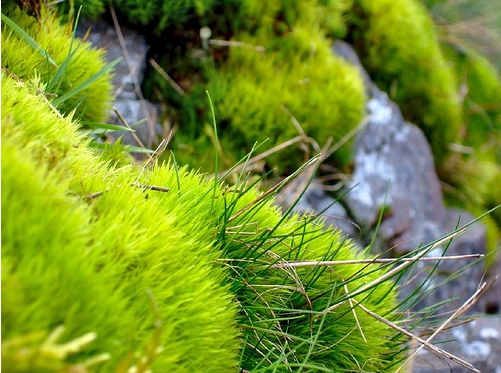


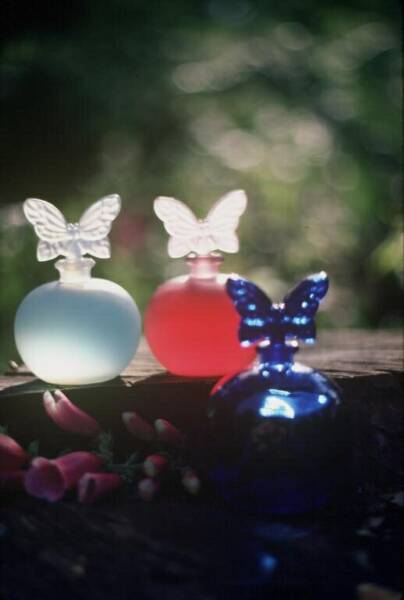
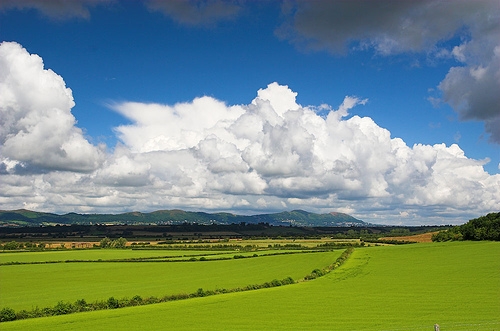

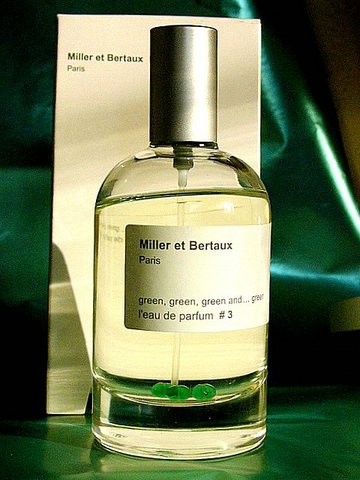

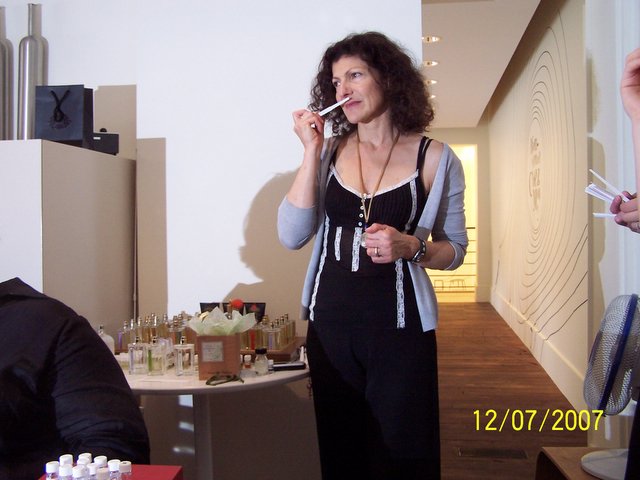

Over the Rainforest
photo courtesy of Givaudan
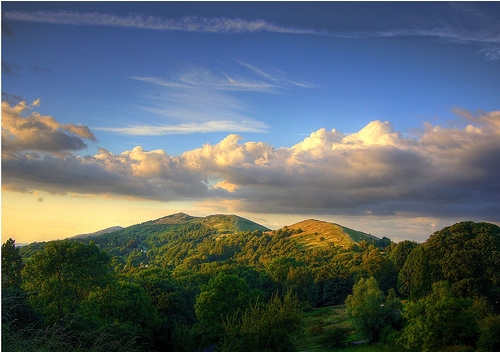
Dr. John King
Pamela Roberts of L'Artisan Parfumeur Paris demonstrates 'Ete Douce.
Perfumes of the Land and Sea
Part Two
By Dr. John King
Dr John King continues his personal Scent Trek in search of perfumes that remind him of home and abroad.
In my first article, I introduced you to my home territory near the Malvern Hills in central England. Malvern was hitherto famous for its water, drunk by the Queen. Now following my article, people may hopefully be aware that it has a fragrant ecology too.
Not a very spectacular one, I admit. From the perfumer’s point of view Malvern remains a rarefied place, characterised mainly by fresh air, stunning views, and the faintest hint of gorse and broom. You might also find some damp mosses if you are lucky and there’s certainly plenty of grass.
But now it’s time for us to really get down to earth. In this issue I’m going to look at the fragrant joys of ploughed fields. Unsurprisingly, we are in the territory of men’s fragrances here – or, with due respect to Nathan Branch 1, those ostensibly intended for men.
Treasures of the Land
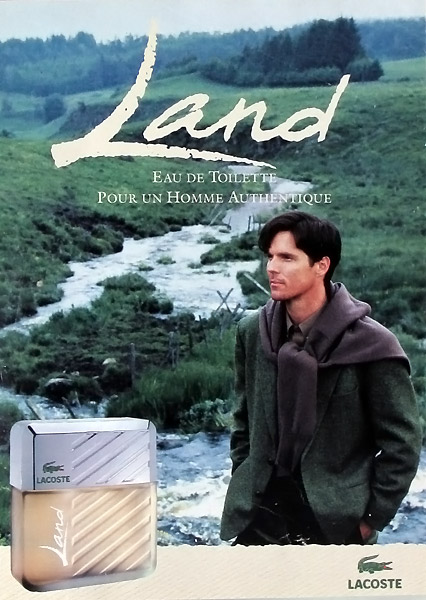
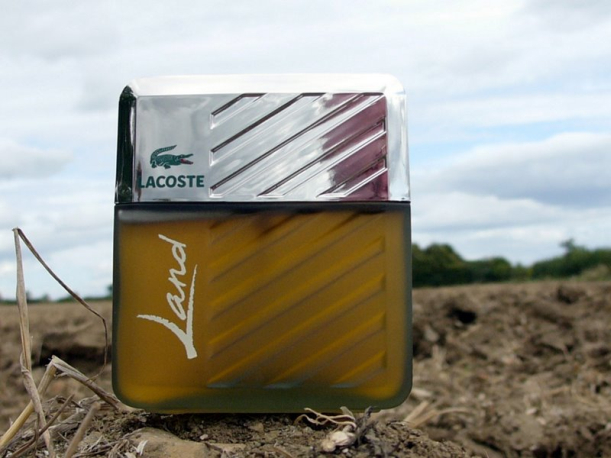
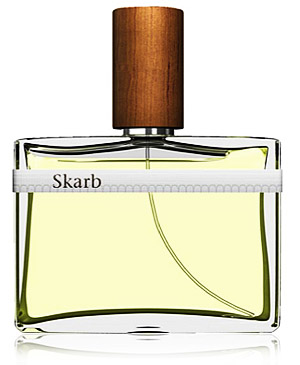
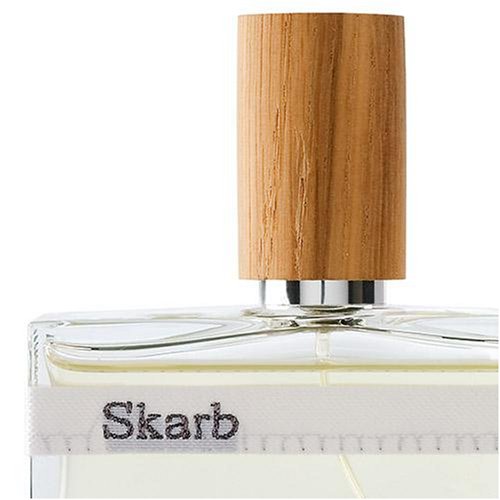


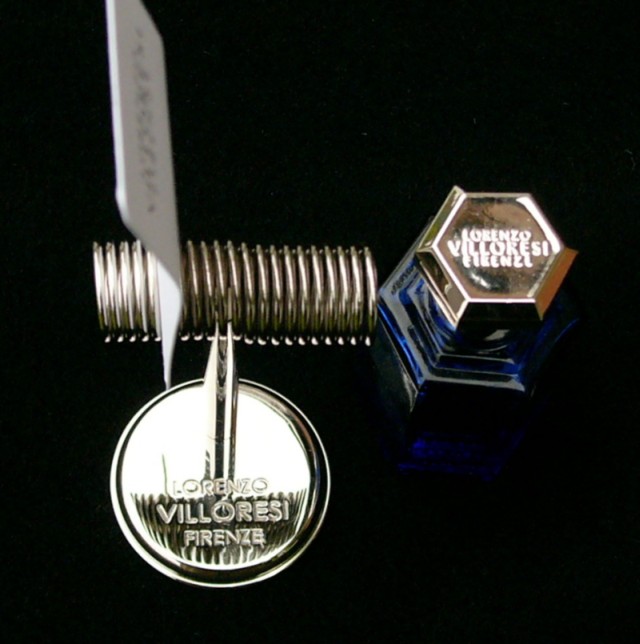
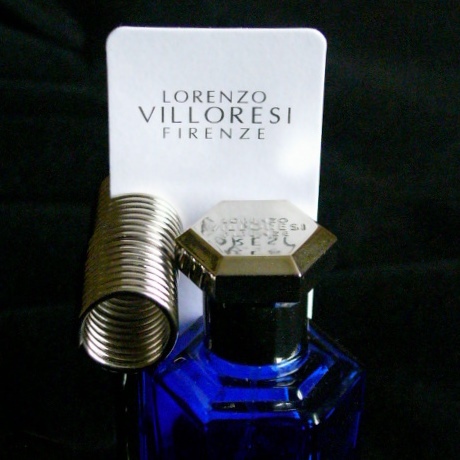
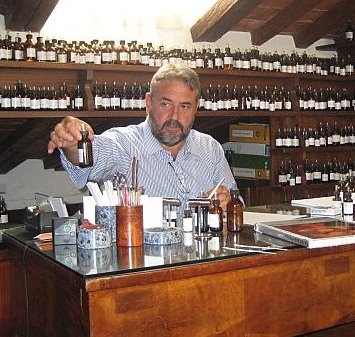
Land, by Lacoste
“The promise of fulfilment for lovers of distant horizons and the subtle perfumes of mountain and moorland, woodland and green hillsides.” I quote from the beautifully written pack leaflet.
It’s more than a promise, too. This fragrance really does deliver the goods. It lives up to its name, giving a convincing impression of the ploughed earth.
The topnote is transparently citrus and green, with a touch of galbanum. (I confess to adding a little more galbanum extract, I love this so much). Underneath is a dry, rich and somewhat vegetable character recalling a large wooden barn stacked with dusty potatoes, carrots and celery. The presentation, in muted greens and browns with a large tractor tyre imprint on the bottle, is absolutely right.
Land was created in 1991, a top quality and most original product firmly aimed at the man who lives by his own rules. “It is suggestive rather of the private enjoyment of the connoisseur than the display of public acceptability”, as the pack so elegantly puts it. Land is very definitely a masculine fragrance too, possibly the last preserve of the independent male after his girlfriends have appropriated most of his other fragrances.
I can’t imagine any lady wishing to smell of ploughed fields, so he is fairly safe with this one.
Like all the best things in life, the fragrance is long discontinued, but bottles still turn up on ebay (avoid the miniatures, which may not always be genuine).
Patchouli by Lorenzo Villoresi
Finally, a fragrance to remind me of my visit to Italy. The Sniffapalooza expedition to Florence last year was a memorable event. And what more memorable place than the penthouse studio of Lorenzo Villoresi, with its panoramic view of the city, its antique furniture and rows of old fashioned dropper bottles?
For anyone over the age of 50, patchouli oil has a powerful resonance. It was the emblem of the hippy movement in the 1960’s, of flower power, the Beatles and the Rolling Stones, not to mention Woodstock. The oil was sold in boutiques under names like Spiritual Sky, its earthy aroma pervaded the bars of my youth. Patchouli is earthy in a different way from both Land and Skarb, with a sweet rootiness and a musty quality which the Villoresi version captures very well.
To make his fragrance, Mr. Villoresi told us, he had blended several patchouli oils in perfect harmony. He handed some smelling strips round. It seemed to me that his dimly lit studio was the perfect place to smell this dark coloured essence with its odour of old wood, old furniture. Perfumers say that adding patchouli to a fragrance is equivalent to transposing the key from major to minor, such is its sombre quality.
And it seemed to me also that Mr. Villoresi was a good person to compose this patchouli perfume, for the guy struck me as a serious and weighty character, a man with a certain gravitas. Faced with the Sniffapalooza invasion of his private atalier, he had reacted with restrained dignity and showed commendable patience.
I am aware of course that Luca Turin, who is a respected scientist as well as a perfume critic, harbours grave doubts about Villoresi’s work. But Turin is not always right. Nobody is always right, because as Tim Girvin 2 said, “Lorenzo’s magic making is all mystery and wonder”. It would be a sad day if the art of composition were reduced to chemical formulas. As long as some mystery remains, perfumery will retain its fascination. The dark side of perfumery does have its attractions, after all.
References
1. Nathan Branch, How men can Learn to Stop Worrying and Love the Unisex Fragrance
Sniffapaloozamagazine Fifi nomination. http://www.sniffapaloozamagazine.com/SNIFFAPALOOZAMAGAZINEFIFITOPFIVENOMINATIONS.html
2. Tim Girvin, Lorenzo Villoresi:
A History of Fragrance Creativity, Sniffapalooza in Florence, Italy
Coming Next Issue; October 10th
Part 3 Perfumes of the Land and Sea
and a review of Gravel
All photos supplies by John King except Land advertisement
Skarb
Following a roughly similar track but readily available and actively promoted is Skarb (meaning treasure), by Humiecki and Graaf. Like Land, it displays a culinary, savoury aspect, due partly to the herb lovage which is common to both fragrances. Smell Skarb and you are standing in a health foods store, surrounded by organic produce, canisters of barley and brown sugar close at hand. But there is also a curious watery-metallic aspect, very like Secretions Magnifiques (Etat Libre d’Orange). The drydown is of the pungent amber-woody type (karanal, for the technically minded) which embellishes many modern masculine fragrances.
In contrast to Land, Skarb ran out of luck when came to the advertising. It was saddled through no fault of its own with an exceptionally silly PR story, something about men feeling gloomy and crying. Tania Sanchez comments on this in the book “Perfumes: the Guide”, which she has co-authored with Luca Turin. It illustrates what might be called the "dark side of perfumery", i.e. we are kept in the dark about the true nature of perfumes, whilst marketers churn out uninformative nonsense. Never mind, as long as folks like Tania Sanchez and Luca Turin are around to set us straight, we will be OK. The internet has opened everything up to intelligent analysis, we are coming out of the gloom and the shadows.
Skarb costs $210 a bottle – nonsense of this calibre is expensive. But I don’t begrudge the money, because the total package is excellent. Skarb is truly a treasure, and one which is likely to appeal to women as well as men. Maybe that’s why the men are crying.
Close to the Land
Transparent topnote
Extra galbanum gives a pleasing variation
The dark side of perfumery: marketing nonsense keeps us in ignorance
Lorenzo Villoresi in his studio
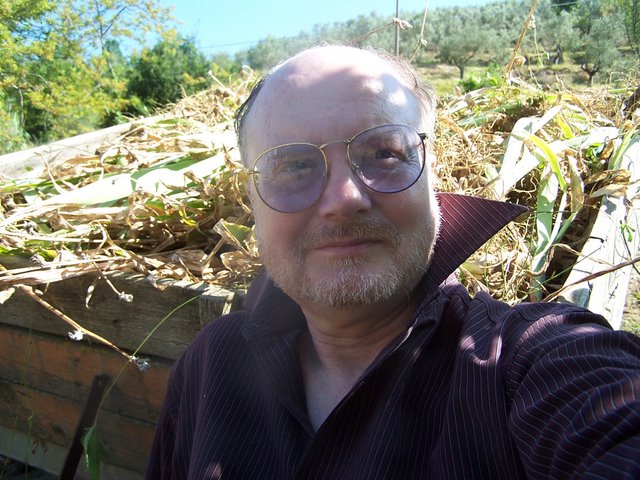
John King resting in front of Iris roots in Florence Italy
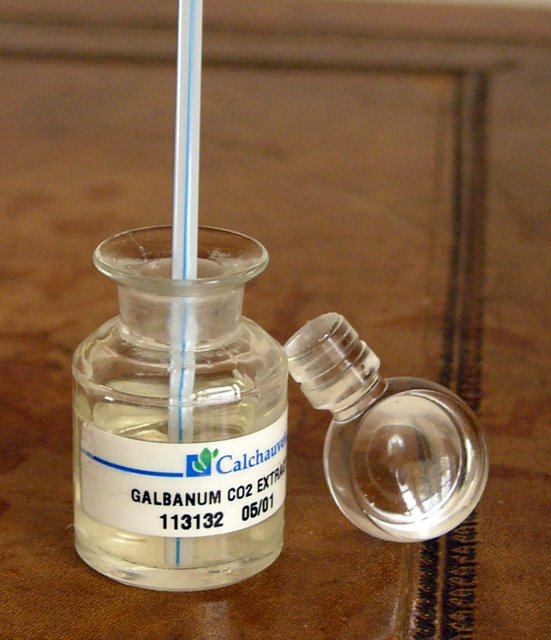
Acqua di Selva (Visconti di Modrone) is crisp, green and bracing. It is a lighter partner to Blenheim Bouquet (Penhaligons, London), and the two go well together. The Italian fragrance gives a youthful burst of topnote freshness whilst the English Eau de Toilette, created in 1902, provides a distinguished and aristocratic background.
Silvestre (Victor) is also wonderfully refreshing, with a spicy herbal shading of clove, thyme and oregano. It has a familiar basenote which puzzled me for a long time until I suddenly remembered where I’d encountered it – in Roger and Gallet’s Savon Fougere soap, a very fine soap from Paris. So here is another potential partnership for your bathroom. The Italian cologne and French soap are made for each other.
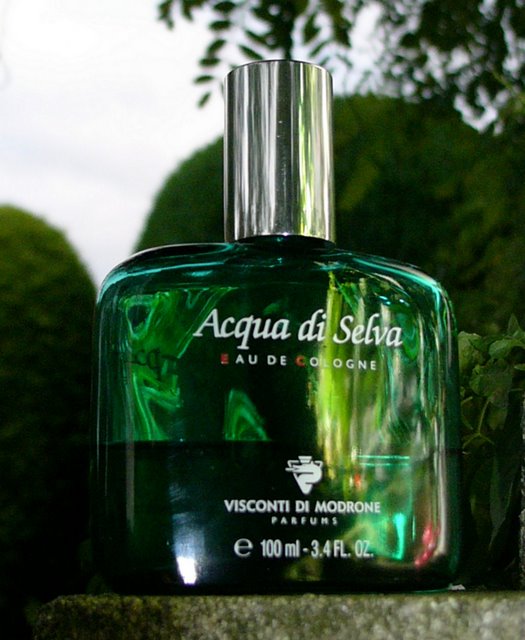

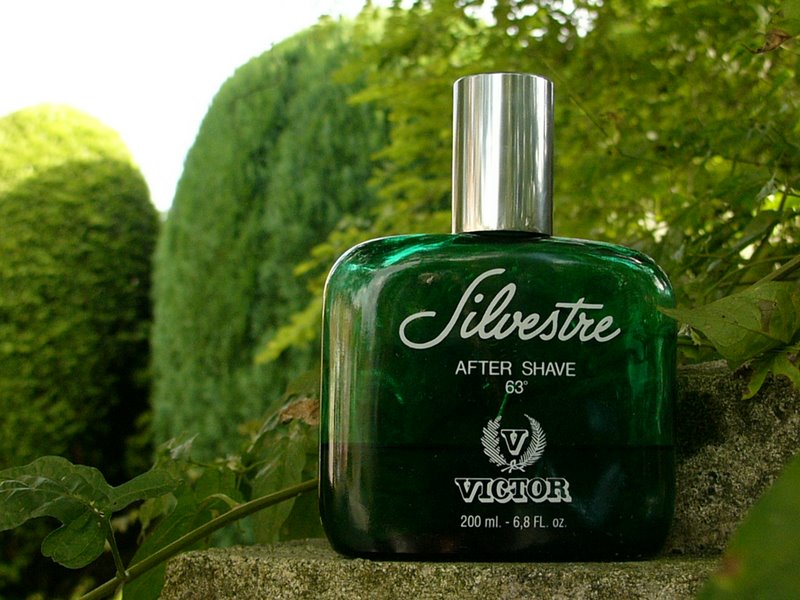



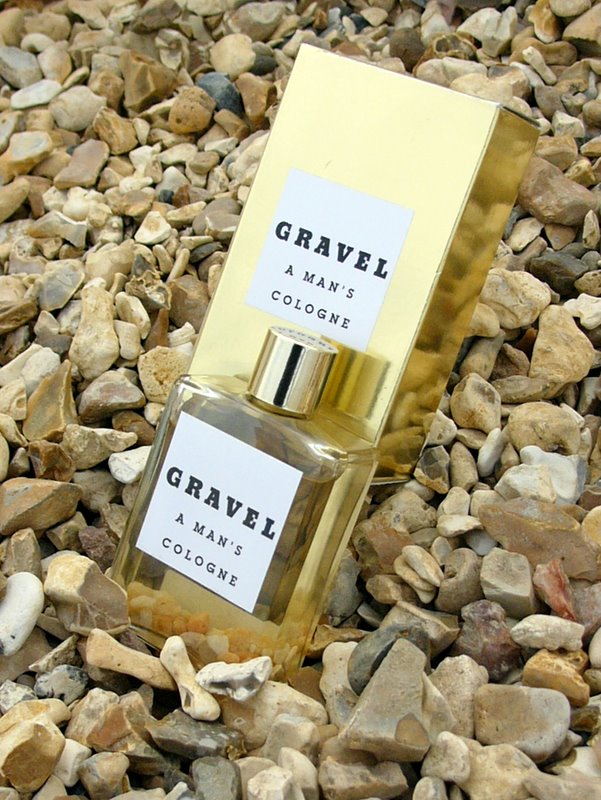
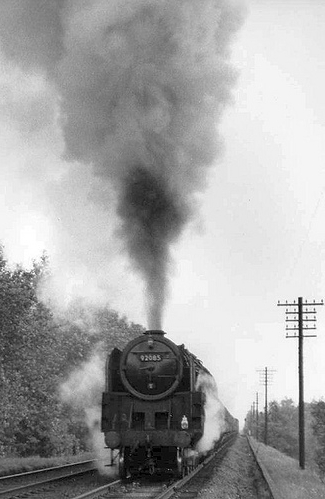
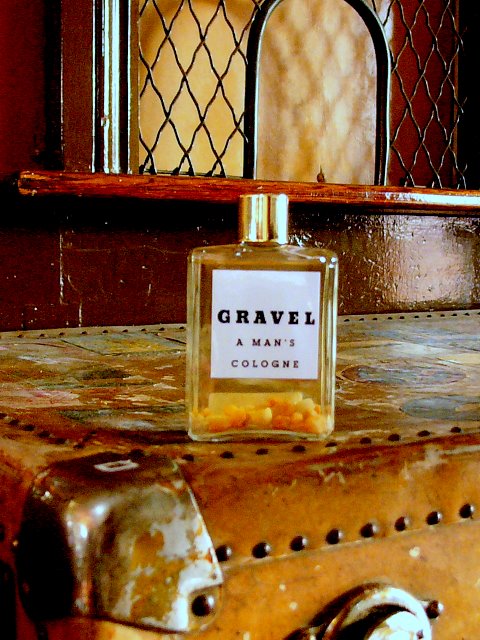
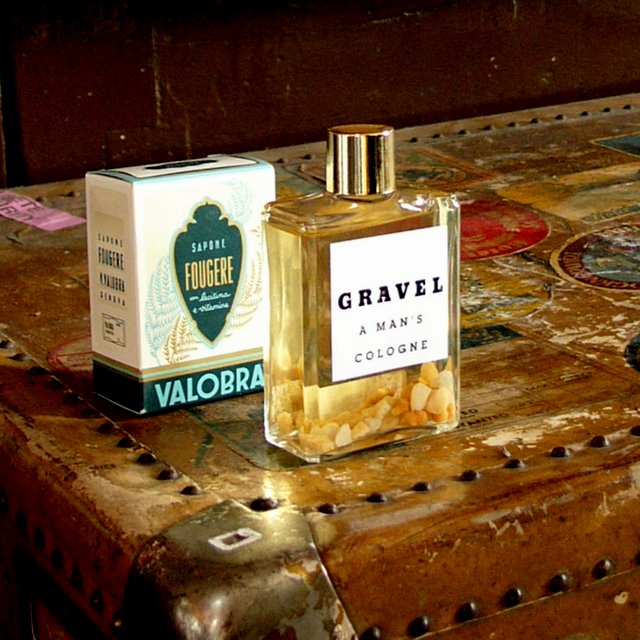

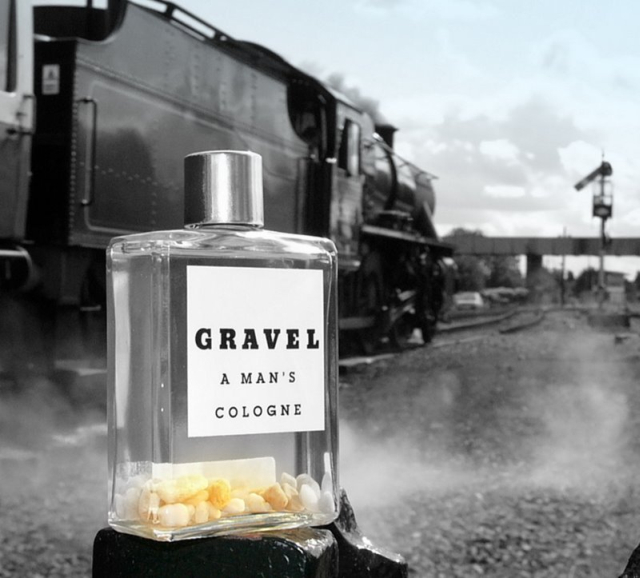
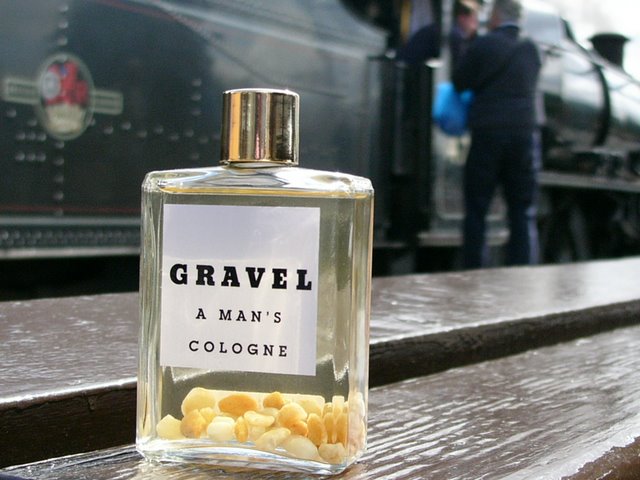
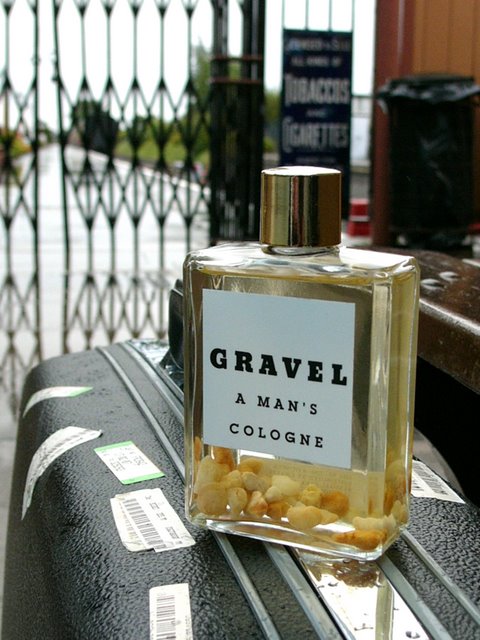

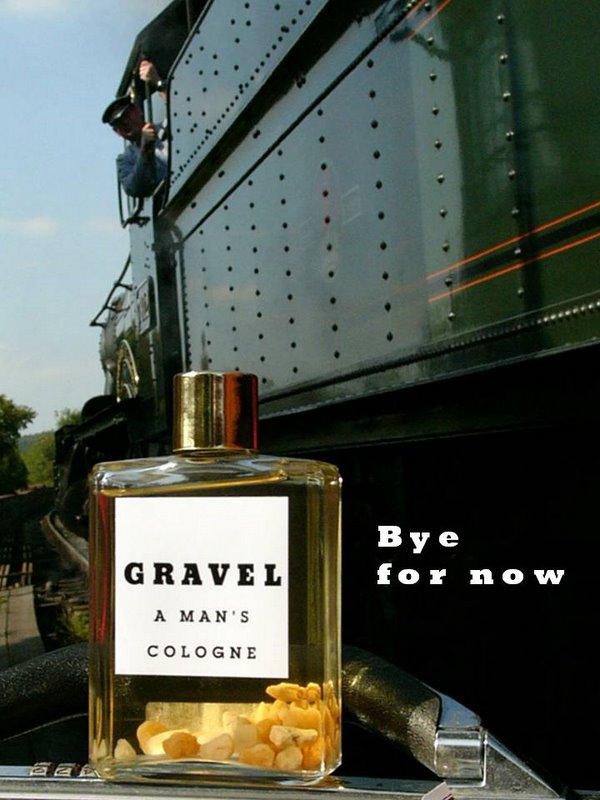
For The Men...
Perfumes of the Land and Sea; Part Three
Men's Fragrance Premiere Review of Gravel Fragrance For Men
By John King
John King continues his personal Scent Trek in search of perfumes that remind him of home and abroad. A must read for the men! (and women looking for unique gifts)
In my first article; Part One, I introduced you to my home territory near the Malvern Hills in central England. Malvern was hitherto famous for its water, drunk by the Queen. Now following my article, people may hopefully be aware that it has a fragrant ecology too.
In my second article, Part Two, we ended up in the rooftop studio of Italian perfumer Lorenzo Villoresi, in Florence. Before we leave Italy I should like to take a quick look at a couple of real Italian classics, the coniferous mens colognes of the 1950’s.
Perfumes of the Land and Sea: Part Three
John King continues his Scent Trek...
Pine Forests of Italy: Acqua di Selva, Silvestre
Sharing the same dark green bottle, these neglected gems deserve a revival - they have a simple discreet freshness difficult to find today. It’s a scent of Alpine forests, which also reminds me of the freshly cut cupressus trees in my garden.
Glories of the Steam Era: Gravel Cologne
Gravel Cologne has just been reintroduced on a temporary basis, and my guess is that there are no more than a handful of bottles in existence. It has been difficult to obtain much official information about it, adding to the mystery and intrigue. It just appeared silently and almost unnoticed, like John Wayne riding into town. Nobody else seems to have written about it so all I can do is to give you my subjective impressions, having sent for a bottle out of curiosity.
Gravel boldly declares itself to be “A Man’s Cologne”, which already makes it an endangered species. However, it is a superb fragrance, and one which could attract a cult following.
The most unusual feature is that it actually contains gravel in the bottle. Apparently this is what gives the fragrance its pale amber colour. I must admit was sceptical when I read that, so I consulted John Ayres, the ex Managing Director of Givaudan UK who is also a geologist. Yes, it’s possible, says John “ The pebbles probably contain minute quantities of iron oxides and other iron and mineral salts which might impart a slight colour to the alcohol over time”. The odour? “I doubt it”, he says, “but flint has a ‘flinty’ smell, and certain wines have a flavour of the rocks where the vines grow”.
So thumbs up to Gravel, let’s give them the benefit of the doubt. Looking at the bottle, it has a delightfully amateur feel about it, which only serves to convince me of its authenticity. The packaging is simple and unpretentious, a gold box minus the usual fancy cellophane. The cologne inside has a slight haze, with a trace of sediment at the bottom. This is the real ale of the perfumery world. Wonderful!
Both these classic colognes are still made by the original firms and to the original formulas, though I doubt if this happy situation will persist indefinitely. At the moment you can find Silvestre on eBay Germany.
One of the basic laws of perfumery, we might call it King’s Law of Perfumery; states that the best products vanish without warning and you cannot buy them again for love nor money. So my advice to readers is this: tune in to eBay.de, invest in a bottle or two, and join me in my garden.
Acqua di Selva - a youthful burst of freshness
Aristocratic pair - Blenheim Bouquet and Acqua di Selva go well together
Silvestre by Victor
As I write the cupressus trees
are receiving their annual cut
Gravel A Man's Cologne
The Lickey Incline typical scene
Photo-Richard Postill
Join me in my garden
The Fragrance - Personal Associations
Gravel is a nostalgic fragrance but also has a modern appeal. A very personal impression is that it takes me back to British Railways in the steam era. I can almost smell the lineside gravel and get a whiff of the stations, together with a hint of old leather.
Gravel was created in 1957, when steam on British Railways had reached the height of its glory and was about to face the final curtain. Those were the days of the Flying Scotsman and the Orient Express, it was an age of pride and glamour. I was 10 years old and we lived at the foot of the Lickey Incline, the steepest mainline climb in England, needing 3 locomotives working flat out to push up every express train towards Birmingham. It was a magnificent sight, almost apocalyptic as these fiery monsters thundered past shooting out sparks like volcanoes, steam hissing from every pipe through lack of maintenance, the noise was deafening and the platform shook and vibrated like an earthquake. No wonder every boy in those days wanted to be an engine driver, including myself, for to control a beast like that was the epitome of manhood.
The smell was a mixture of hot oil and coal, superheated steam and something extra, indescribable, which marketers nowadays would probably call “steam engine accord"
So maybe we can say Gravel has a steam engine accord, though they didn’t talk in those terms in 1957. It certainly evokes the same sort of passions, and it’s masculine for the same reasons. Like other favourites – such as Skarb and Sables – it is smoky, burnt and evocative.
Elegant Drydown
A particular strength of this fragrance is the drydown. The drydown or basenote I always think is the most important part of any perfume, because that is what the regular wearer comes to smell like. Any man who uses the ubiquitous cool water – or one of its many relatives – can be identified from ten paces by the odour of ambroxan, a strong and long lasting chemical which smells like poor quality cigars.
Those who wear Gravel will have no such worries, for the drydown is impeccably discreet and elegant, the merest a hint of powdery-soapiness a la Monsieur de Givenchy.
That perfume, launched two years after Gravel in 1959, remains unsurpassed among masculine fragrances. At least, that’s the opinion of the respected blog Now Smell This, and I agree. So Gravel, despite its gritty name, could not be more refined.
To splash on this refined cologne is to journey back to a more leisured and privileged time. A time when a gentleman would entertain his chums over long weekends at his country house. There would be occasional trips to the continent accompanied by a selection of soaps and colognes thoughtfully packed by his valet.
A first class ticket to nostalgia
A Soap to Harmonise
Talking of things your valet might pack, in the first instalment of my Scent Trek I was going into raptures about Valobra’s fougere soap. This differs from the Roger and Gallet product in having a pronounced hayfields note of coumarin or tonka bean, alongside a rich Indian attar background suggesting (to the present writer) exotic travel to far flung outposts of the British Empire. It finds a soulmate in Gravel Cologne, which by coincidence has that same tonka aspect. So once again we have discovered a couple of potential partners, from different firms but good travelling companions.
In case anyone is wondering why I am bothering to set up as a matchmaker for long established soaps and colognes, bear in mind that the fragrance market is a constant struggle for existence and these relatively obscure products don’t have an army of line extensions. It’s nice if one can find unsuspected affinities between them, to help them along as it were.
Acknowledgements
Thanks to Raphaella for encouraging me to write this series. It has given me the perfect excuse for rediscovering my boyhood, a significant part of which was spent on the stations of British Railways.
By the way, for my more ardent fans, I have also dusted off my guitar and written a song about my wanderings round Europe.
Special thanks also to Ausliebezumduft, whose generous sample programme has enabled me discover many a fine product.
Link this to their website http://www.ausliebezumduft.de/index.php
Photography by the author, except where otherwise credited.
Will it succeed?
I hope so. On its side, it has a name that’s hard to beat. I love these macho, hard-nosed names, which contrast with the elegance of the product. Tough exterior, heart of gold, it’s a winning formula. I once invented an aftershave called Thug which was for men who are “worse than a Brut”, and it sold like hot cakes to my fellow students.
I followed it up with the perfume Nightshade, “the deadliest poison” which didn’t seem to catch on at first but some firm whose name I forget took the name Poison and ran with it. If Gravel takes off, one can envisage imitators with names like Flint, Granite and Gunsmoke.
But first it has to defy King’s Law and survive. Rare and wonderful things are prone to extinction unless people discover them. I’m glad to have discovered Gravel, and I hope it goes far.
Gravel is obtainable from Ausliebezumduft
John King's Tip:
Ausliebezumduft gives 3 free samples with every purchase and the samples are generous minisprays
they don't publicise this, so readers have to remember to type in whatever they want,
in the comments box. Samples are also sold separately and are good value.
All rights reserved 2006-2009. All content belongs to Sniffapalooza Magazine. All articles by individual writers and contributors, understand and agree that each article that is accepted by the Editor for publication; becomes the property of Sniffapalooza Magazine for the sole purpose of publication for Sniffapalooza Magazine. Articles may be archived for permanent use on the web site for Sniffapalooza Magazine and for future issues.
All articles remain the property of Sniffapalooza Magazine for display purposes only.
John has a great video featured here with many wonderful photographs.
I would also like to thank him for all of his hard work on his wonderful Three Part series, he has produced a wonderful article and he has opened a view into a another world for many of us. Thank you from myheart; for all you have done!
-Raphaella
But for the all-time best hayfields aroma I have ever some across, we have to leave the realm of fine fragrance and go to a humble soap. My wife still recalls the time when a workman came to our house to fix a floorboard and demanded repeatedly to know 'what is that wonderful smell in your bathroom?' It was Valobra’s fougere soap, which the ancient Italian house makes according to traditional methods. Needless to say, I have laid in a large supply lest it should ever be discontinued.
Moss
The British Isles enjoys (if that is the right word) a cool, damp and misty climate where mosses thrive. In perfumery the odour is represented by oakmoss and treemoss, a chief building block of the chypre family. There is just one fragrance which says‘moss’ to me
however, and that is Lorenzo Villoresi’s Uomo. It is more elegant than Ralph Lauren's Polo, lacking the unpleasant patchouli undertone which accumulates on anyone who wears the latter. Uomo reminds me that when I was 16, I had to I had to get down on my hands and knees on biology field trips to study mosses at close quarters. The name
of one of them is still etched on my brain: hypnum cupressiforme.
Green perfumes
Although Floral notes dominate perfumery, to my mind green notes are more interesting – both now and for the future. Green has come to symbolize everything good, indeed we
even have a green party in English politics.
The example of a green perfume always quoted is Balmain’s Vent Vert but this is
quite floral too, so let us look at some true green notes. I have chosen one for its stridency and the other for its subtlety.
Green, green green…and green By Miller and Bertaux
Here we have a powerfully green fragrance, a single spritz of which will impact on your consciousness for a long time. The exact shade of green it represents has provoked plenty of debate on MakeUpAlley, for example:
"A light, iridescent, shimmering green of late spring."
"A bright, unswervingly cheerful, sweet green."
"A roll down a grassy hill laughing when you're a kid green."
It is bitter-minty at first, with a garden twigs aspect. Later it becomes fruity in a way which for me stirs recollections of picking blackberries. Especially the delicious aroma which
later filled the house when blackberry jam was being made. So plenty of memories out of this bottle, and the box has an intriquing design into the bargain.
Calamus (Comme des Garcons Series 1: Leaves)
Luckyscent hails Calamus as the crown jewel of all green scents, redolent of living plants, of freshly crushed stems and crumpled leaves.
"It’s the scent of a meadow trampled by fairies and woodsprites" they enthuse, their imagination running away with them as usual.
Independent reviewers agree, reporting nostalgic associations to the gardens of their childhood. They perceive a soft and mellow green, gentle and sweet, "like the milkiness that oozes from a just -popped dandelion stem". King of England’s verdict? I see a brick outhouse well stocked with plants, but it’s so realistic that I smell the bricks as well as
the plants. A first class composition in best Comme des Garcons tradition. It gets the Royal Warrant.
In the next issue:
The fragrant joys of ploughed fields and allotments.
Watery whiffs of the Netherlands. California dreamin’
